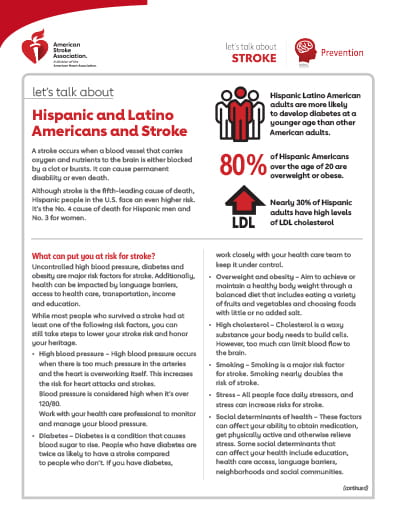Let’s Talk About Hispanic and Latino Americans and Stroke
 A stroke occurs when a blood vessel that carries oxygen and nutrients to the brain is either blocked by a clot or bursts. It can cause permanent disability or even death.
A stroke occurs when a blood vessel that carries oxygen and nutrients to the brain is either blocked by a clot or bursts. It can cause permanent disability or even death.
Although stroke is the fifth-leading cause of death, Hispanic people in the U.S. face an even higher risk. It’s the No. 4 cause of death for Hispanic men and No. 3 for women.
Hispanic and Latino American adults are more likely to develop diabetes at a younger age than other American adults.
80% of Hispanic Americans over the age of 20 are overweight or obese.
Nearly 30% of Hispanic adults have high levels LDL of LDL cholesterol.
What can put you at risk for stroke?
Uncontrolled high blood pressure, diabetes and obesity are major risk factors for stroke. Additionally, health can be impacted by language barriers, access to health care, transportation, income and education.
While most people who survived a stroke had at least one of the following risk factors, you can still take steps to lower your stroke risk and honor your heritage.
- High blood pressure – High blood pressure occurs when there is too much pressure in the arteries and the heart is overworking itself. This increases the risk for heart attacks and strokes. Blood pressure is considered high when it’s over 120/80. Work with your health care professional to monitor and manage your blood pressure.
- Diabetes – Diabetes is a condition that causes blood sugar to rise. People who have diabetes are twice as likely to have a stroke compared to people who don’t. If you have diabetes, work closely with your health care team to keep it under control.
- Overweight and obesity – Aim to achieve or maintain a healthy body weight through a balanced diet that includes eating a variety of fruits and vegetables and choosing foods with little or no added salt.
- High cholesterol – Cholesterol is a waxy substance your body needs to build cells. However, too much can limit blood flow to the brain.
- Smoking – Smoking is a major risk factor for stroke. Smoking nearly doubles the risk of stroke.
- Stress – All people face daily stressors, and stress can increase risks for stroke.
- Social determinants of health – These factors can affect your ability to obtain medication, get physically active and otherwise relieve stress. Some social determinants that can affect your health include education, health care access, language barriers, neighborhoods and social communities.
What can you do to cut your risk?
Some stroke risk factors can’t be controlled, such as age, gender, social conditions, family medical history and previous strokes. But still, you can greatly reduce your risk of stroke by:
- Eating more fruits and vegetables.
- Reducing salt in your diet.
- Increasing your physical activity.
- Quitting smoking (or not starting).
- Maintaining a healthy weight (your health care team can help you figure out what that is for you).
- Manage stress.
Talk with your health care team about your risk factors so you can understand how to manage them.
Stroke warning signs
Stroke is an emergency! Call 911 immediately if you see one or more signs of a stroke. Fast treatment can make the difference between life and death.
Signs and symptoms can be different depending on what part of your brain is impacted. F.A.S.T. can help you recognize several common stroke symptoms and remember what to do.
F - Face drooping
A - Arm weakness
S - Speech difficulty
T - Time to call 911
How can I learn more?
- Call 1-888-4-STROKE (1-888-478-7653) or visit stroke.org to learn more about stroke or find local support groups.
- Sign up for our monthly Stroke Connection e-news for stroke survivors and caregivers at StrokeConnection.org.
- Connect with others who have also had an experience with stroke by joining our Support Network at stroke.org/SupportNetwork.
Do you have questions for the doctor or nurse?
Take a few minutes to write your questions for the next time you see your health care provider. For example:
What medical conditions do I have that put me at higher risk for stroke?
What lifestyle changes can I make to reduce my risk of stroke?
We have many other fact sheets to help you make healthier choices, manage your disease or care for a loved one.
Visit stroke.org/LetsTalkAboutStroke to learn more
© Copyright 2022 American Heart Association, Inc., a 501(c)(3) not-for-profit. All rights reserved. American Stroke Association is a registered trademark of the AHA. Unauthorized use prohibited. DS18658 1/22